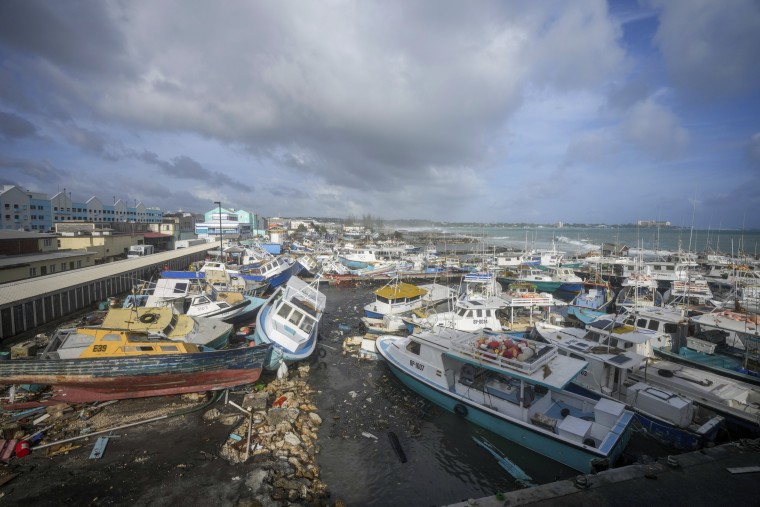 Science & Environment
Science & Environment
Hurricane Beryl reaches record winds of 165 mph as…
Hurricane Beryl has claimed at least four lives in the Caribbean as it continues to bring heavy rainfall, “life-threatening” winds and flooding to the region this week, with forecasters warning that it could remain at least a tropical storm as it moves towards Mexico.
The National Hurricane Center said in an update early Tuesday that the storm, which remains a Category 5 and is currently in the Caribbean Sea some 235 miles southeast of the Dominican Republic, had sustained windspeeds of almost 165 mph — making it the strongest July hurricane ever recorded, beating Emily from 2015. In an afternoon update, the center said maximum sustained winds had gone down slightly to 160 mph with higher gusts.
Three people were killed in Grenada and one person was killed in St. Vincent and the Grenadines, according to officials, who warned there could be more fatalities. In Grenada, two people died in Carriacou Island and one person died after a tree fell on a home on River Road.
Grenada Prime Minister Dickon Mitchell said that there are many downed power lines and roads that are not passable due to debris in the island nation.
“The situation is grim,” Dickon said. “There is no port. There’s almost complete destruction of homes and buildings on the island.”
The NHC said Beryl is moving westward across the Caribbean at around 22 mph, which should continue through Wednesday when it is forecast to pass near Jamaica. The hurricane will then approach the Cayman Islands Thursday before reaching the Yucatán Peninsula at night.
“Weakening is forecast later today, but Beryl is still expected to be near major hurricane intensity as it moves into the central Caribbean and passes near Jamaica on Wednesday and the Cayman Islands on Thursday,” the center said in an update Tuesday. “Additional weakening is expected thereafter, though Beryl is forecast to remain a hurricane in the northwestern Caribbean.”
Jamaica upgraded its advisory to a hurricane warning, up from a watch, and Prime Minister Andrew Holness urged people to be prepared and seek higher, safer ground. He also warned that emergency services would not be able to operate during the peak of hurricane conditions.
“We have an impending disaster and we have to treat it with the seriousness that it requires,” Holness said. “We will have some adverse weather impacts, whether it is a direct hit or a glancing blow… and therefore everyone needs to be now in a mental state of readiness.”
A large swathe of the Caribbean is now preparing for significant impact and damage this week. Jamaica remains subject to a hurricane warning, with heavy rain and flooding likely there on Wednesday.
The storm surge in Jamaica could reach 5 to 8 feet above normal tide levels, with up to 12 inches of rain possible there and the southwestern Haitian peninsula through Wednesday. In the Cayman Islands, storm surge could raise water levels 2 to 4 feet above the norm.
The effects of Beryl could even reach the continental U.S., with minor coastal flooding in southeast Texas or southwest Louisiana, according to the National Weather Service field office in Lake Charles, Louisiana. More impacts are possible if the hurricane moves further north than expected.

Tropical storm warnings are in place for the south of Hispaniola — the island that consists of Haiti and the Dominican Republic — while a hurricane watch is in place for the south coast of Haiti and the Cayman Islands.
Beryl is the first hurricane classed as category 4 or higher to appear in June and the earliest category 4 storm of the Atlantic hurricane season. It’s also the strongest hurricane to pass through the Windward Islands, which include Grenada, St. Vincent and the Grenadines, Saint Lucia and Martinique.











